Is CeilingLink® a suspended ceiling system?
No, CeilingLink is a direct-mount ceiling grid system; it is
NOT a suspended system hung by wires. The total thickness of a CeilingLink installation
including the ceiling panels is 1".
What tiles or panels may be used with CeilingLink?
CeilingLink is used with standard, recessed, and decorative 2x2 or 2x4
acoustic ceiling panels that are up to 3/4" thick. 98% of ceiling panels made in the
US or Canada can be used with CeilingLink.
Do you also sell ceiling tiles or panels?
We don't sell ceiling panels because of the high cost of
shipping. Ceiling panels are sold in most building supply stores, such as
Home Depot,
Menards, and
Lowe's, or your local lumber yard.
Armstrong,
USG,
and CertainTeed are the major manufacturers of ceiling tiles and panels.
Ceilume Ceiling Tiles
are decorative ceiling panels that are compatible with CeilingLink.
Precision Tile
is an inexpensive software tool for helping plan your ceiling tile installation.
How much does a CeilingLink ceiling cost?
For the grid system, figure about $1.00 per square foot using 2x4
panels, or $1.10 per square foot using 2x2 panels; figure about $.50 per square foot and
upwards for the ceiling panels. Use our handy CeilingLink Calculator
to determine how many lengths of CeilingLink and L-Channel to order based on room length
and width dimensions. The Calculator figures material for the complete grid system,
including the top track, bottom runner, cross-tees (bottoms only); and it also calculates
weights, prices, square footage, and the number
of drywall screws required for your order.
How is CeilingLink shipped?
We ship CeilingLink, L-Channel, and C-Channel in custom-made 8-foot
cardboard boxes or tubes via FedEx or UPS Ground (no signature required for residential deliveries); estimated
shipping time is 1 to 5 days to most domestic USA locations from our Chicago area warehouse.
Most orders received are shipped on the same or next day (except weekends & holidays).
We also ship to Canada for an additional charge; call or email for a quote. Please note our
current SHIPPING PROMOTION of a flat $29 to domestic US locations.
Do you ship 4-foot lengths of CeilingLink?
If you need to order a few extra lengths of CeilingLink or L-Channel,
consider taking delivery of half-lengths to save on shipping. We can ship up to 12 half-lengths
(4-foot instead of 8-foot) to domestic US locations for $15. If you place your order online,
let us know with an email or phone call that you want half-lengths, and we will refund $14
of the $29 shipping charge.
What is CeilingLink made of?
CeilingLink, L-Channel, and C-Channel are made in the USA of the same strong
and durable PVC plastic that is used in the framing of
replacement windows, and in residential plumbing systems.
What are the actual dimensions of CeilingLink, L-Channel, and C-Channel?
CeilingLink and L-Channel are 15/16" in actual width, the same as most
standard suspended grid. C-Channel is 15/16" on the bottom, 17/16" on the vertical side, and
1 5/32" on the top horizontal side.

Does CeilingLink have a fire rating?
The PVC plastic used to make CeilingLink has a Class A fire rating--which
means that it does not spread fire, but it does spread smoke and will
melt when exposed to flame.
What is CeilingLink attached to?
The CeilingLink top track is attached to ceiling joists, or
furring that is attached securely to joists. CeilingLink may also be attached to
existing drywall or 12x12 tongue & groove ceiling tiles.
What if the joists or beams are not even?
The 1/4" - 5/16" of play between the top track and bottom runner of CeilingLink is used
to level the bottom runner when the installation of the top track is not level. It is rare
for joists or furring to be perfectly level, and this EXCLUSIVE feature of CeilingLink means that
no shimming of the top track is necessary (up to 5/16" off-level) to achieve a level installation
of ceiling panels.
How is CeilingLink attached?
The CeilingLink top track is attached with standard drywall screws on 16"
centers along alternating sides of the top track, using the small screw grooves on the underside
of the top track. CeilingLink top tracks are attached in parallel on 24 1/8" centers to joists
or furring; the additional 1/8" is required to accommodate the thickness of the center joint
created by joining CeilingLink to itself.
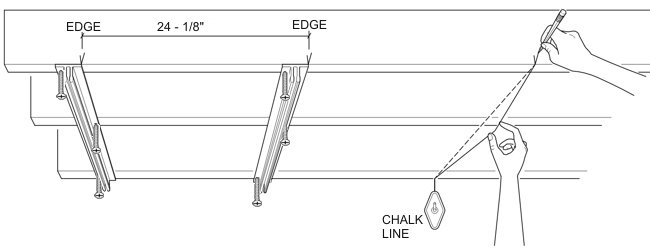
How is CeilingLink attached to existing drywall or tongue & groove tiles?
CeilingLink is attached to existing drywall or tongue & groove tiles using
longer drywall screws to reach the joists or furring that the existing drywall or tongue & groove
tiles are attached to.
What length of drywall screws should be used?
7/8" or 1" screws are sufficient to attach CeilingLink directly to joists
or furring.
1 1/2" or 1 5/8" screws are sufficient to attach CeilingLink to existing 1/2" drywall or tongue
& groove tiles. In general, if CeilingLink is installed over existing drywall or other material,
add 1" to the thickness of existing material to determine screw length, which must be long enough
to anchor CeilingLink securely into the joist or furring that the existing drywall or other
material is attached to.
What is used at the perimeter of a CeilingLink installation?
L-Channel or C-Channel is used to support ceiling panels at the
perimeter of a CeilingLink installation. In small spaces less than the 24" width of a ceiling
panel, CeilingLink may be used on one or two sides of the perimeter to ease the installation of
ceiling panels into the

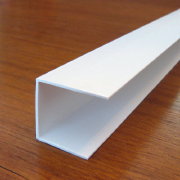 small space.
small space.
C-Channel may be attached to the horizontal surface
above, unlike L-Channel, which is attached to a vertical surface.
The top side of C-Channel is 7/32" longer than the bottom side.

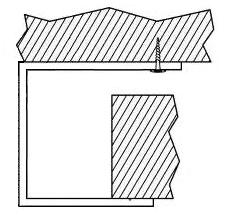
C-Channel is useful around stairwell openings, against concrete walls or steel beams,
or on the bottom outside corners of soffits and box-arounds.
Can a crown or other molding be used in place of L-Channel at the
perimeter?
Yes, a crown or other molding can be used as an elegant solution for the perimeter.
Ceiling panels will rest on the top surface of the crown, which should be installed with the top
at the same level as the bottom of an L-Channel, if it were installed. Crowns and other moldings
are sold in most building supply stores.
What tool is used to cut CeilingLink?
Hand-held anvil cutters work best for cutting CeilingLink, cross tees, and
L-Channel. These cutters are also known as anvil pruners (in the gardening world), and they give
a cleaner cut compared to tin snips or other metal cutters. A fine-toothed hack saw or crosscut
saw or a power miter saw with a fine-toothed blade will also make a clean cut.
How is the CeilingLink bottom runner attached to the top track?
The CeilingLink bottom runner is squeezed into the top track starting at
one end, and working gradually towards the other. Note that CeilingLink's joining legs are a
little off-center on the base, so that the bases of the top track and bottom runner are aligned
and parallel when properly attached to each other.
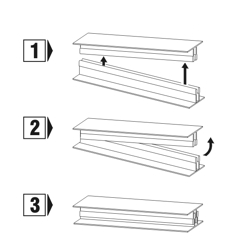
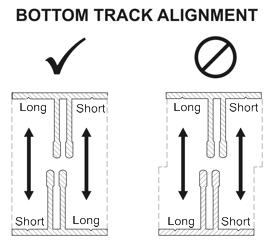
If the top and bottom are not aligned when
attached to each other, disengage and reverse the bottom runner 180 degrees before re-attaching
to the top track. The best way to remember this joining rule is: "long to short", where the
longer base of the top track is directly above the shorter base of the bottom runner, and the
shorter base of the top track is directly above the longer base of the bottom runner. This description
of how to join CeilingLink sounds more complicated than the actual process, which is quite simple.
How are ceiling panels installed into CeilingLink?
Ceiling panels slide between the CeilingLink top track and bottom runner
when the bottom runner is squeezed into the top track. If installing from left to right, the
left track & runner will be fully closed to support the left side of a ceiling panel, while the
right track & runner will be partially closed to allow the right side of the ceiling panel to
slide into the partially closed section. Again, this description sounds more complicated than
the actual process, which is quite simple.

How are middle ceiling panels removed from a finished
CeilingLink ceiling?
Middle panels can be removed carefully by themselves, by lowering
and tilting the bottom runner on one side while holding the adjoining panel in position
until the lowered bottom runner is restored to a closed position. Panels adjoining the
cross tee on one side of the panel being removed need to slide a little (about 1/4-inch)
to provide clearance for the end of the panel being removed.
Another strategy for removing
middle panels is to remove an end panel in the same row and slide adjoining panels out
until the middle one is removed. See the short video for removing a tile on our
installation page: Installation.
How are cross tees created and installed?
Cross tees are cut to 23 3/4" from the same 8-foot pieces used for top
track and bottom runner. The cross tee rests on the CeilingLink bottom runner without being
attached to the top track or having a top track of its own. About 1/4" of the cross tee ends
are supported by the bottom runner or L-Channel (see photos below).


Because CeilingLink is made of PVC plastic, it is also possible to nip or
cut away 1/4" of the cross tee base that lays on the runner, so that the vertical legs of the
cross tee lay on the bottom runner, and the base of the cross tee is then at the same level
as the base of the bottom runner or L-Channel (see photos below).


Do you sell pre-cut cross tees?
We don't currently sell pre-cut cross tees. If you are cutting a large
number of cross tees, a power mitre saw or table saw with a fine-tooth blade will help do the
job quickly; also, there is less waste in custom cutting the shorter cross tees used at
the perimeter.
What is the total thickness of a CeilingLink installation, including
ceiling panels?
It's 1" from the top of the top track to the bottom
of the fully extended bottom runner. Compare this to the 4" - 12" necessary for
a suspended ceiling system.
What can be done about pipes and ducts that are below the joists?
In many cases, furring (1x2s or 2x2s) can be installed to put the mounting point
for CeilingLink below pipes and conduit, and ductwork can be covered with soffits. In some cases,
pipes can be raised a little or relocated in order to free up a larger area of joists that can be
directly attached to. The drawing below shows CeilingLink used with a soffit.

Can CeilingLink be used to support drywall?
No, CeilingLink cannot be used to support drywall (1.7 lbs
per sq ft for 1/2" drywall), which is heavier than most acoustic ceiling panels.
Typical 2x2 and 2x4 acoustic ceiling panels weigh about 3/4 lb per sq ft, and
we recommend using panels that weigh less than 1 1/4 lb per sq ft.
Can CeilingLink be used with light fixtures?
Yes, CeilingLink can be used with light fixtures.
Fixtures must be mounted and supported independently of CeilingLink, and
ceiling panels cutout to accommodate finish rims for cans, high
hats, or other recessed lighting. Larger fixtures, such as 2x2 or 2x4 fluorescents,
are designed to fill the space normally occupied by 2x2 or 2x4 ceiling panels.
Light fixtures should be mounted so that the finish rim will be flush with ceiling panel
bottoms, which are typically 1-inch below the mount point of the top track.
Is CeilingLink available in colors other than white and black?
CeilingLink and L-Channel are currently available in white and black, and they
may be painted many other colors of your choice. Krylon makes a
plastic spray paint--
Krylon Fusion--that comes in a variety of colors and is widely available at Ace Hardware,
Do-It-Best, Kmart, Sears, True Value, Wal-Mart, etc.
Click here for the Krylon store locator.
Can CeilingLink be attached directly to metal joists, studs, or furring?
Yes, CeilingLink can be attached directly to metal joists, studs, or
furring, using standard self-tapping sheet metal screws that are 1/2" - 5/8" in length. See
"How is CeilingLink attached?" above for on-center attachment dimensions.
How does CeilingLink compare to CeilingMAX?
CeilingLink competes with CeilingMAX on price (about 30% - 50%
cheaper, with no retailer markup) and simplicity:
the same piece is used for top track, bottom runner, and cross tee, compared to 3
separate CeilingMAX pieces. Also, there is less flexibility in the CeilingMAX grid
system--every part snaps or fits to the others in required ways--compared to CeilingLink's
grid system, which offers leveling, is more forgiving, and allows more variation,
especially around the perimeter of an installation where the ceiling panels and grid
parts need to be cut to size. The flexibility of CeilingLink allows a
more precise installation than CeilingMAX, but the finished look is
pretty much the same. Both products use white bottom runners that are
15/16" wide, which is the industry standard for 1" (nominal) suspended
ceiling grid systems.
Home Depot, Amazon, and Lowe's are selling CeilingMAX in 100 sq ft bundles
for about $140. This translates to $1.40 per sq ft, a 30% difference
over CeilingLink, not including the additional waste of buying material you don't need.
More questions or comments?
Send your email to:
support@kensa.com
|






 small space.
small space.








